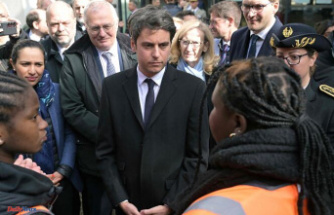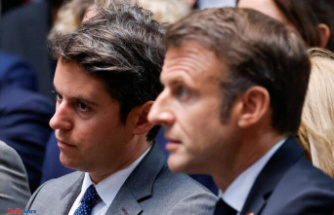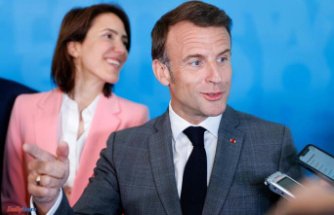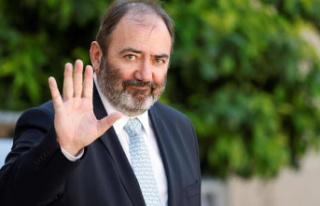With Lysychansk, another large eastern Ukrainian bastion fell at the weekend. As the Kremlin moves closer to one of its war goals, Kiev's successes remain dependent on the West.
In fact, it was the first time in a long time that Russian Defense Minister Sergei Shoigu had delivered anything resembling a victory to his boss Vladimir Putin. Well, again after weeks of bitter fighting, Shoigu was able to announce at the weekend that the two twin cities of Lysychansk and Sievjerodonetsk - and with them the entire Luhansk Oblast - have been taken. At the end of May it took a similar amount of time to capture the southern Ukrainian port of Mariupol.
From Moscow's point of view, the capture of the two cities has multiple meanings. First, there is the symbolic value. After war broke out in eastern Ukraine in 2014 and the city of Luhansk fell into Russian hands, Sievjerodonetsk served as the Ukrainian government headquarters for the district - and, like Mariupol, was thus a symbol of the Ukrainian resistance.
And the conquest is also of value to Moscow militarily. "As long as Russia is attacking the city itself, the Ukrainians can engage the Russian armed forces in house-to-house fighting," military expert Gustav Gressel told ntv.de. "It's an advantage for the Ukrainians because they have more infantry but fewer heavy weapons." With the Russian troops, it's exactly the opposite: "They are being forced into terrain for which they have the wrong setup," says the Russia expert and Senior Policy Fellow at the European Council on Foreign Relations (ECFR).
From the Ukrainian point of view, the time gain associated with this no longer applies. Oleksiy Arestovych, Ukraine's presidential adviser, nevertheless called it the last Russian victory on Ukrainian territory. And did not rate it as a particularly great success. After all, it took Moscow around 90 days to take over the two medium-sized twin cities - and in some cases to raze them to the ground. Weeks ago, the Kremlin troops destroyed all bridges leading to Sievjerodonetsk to cut off supply routes. Lysychansk was once an industrial city, but was completely destroyed in the Russian war of attrition.
In the end, a Russian breakthrough south-east of Lyssychansk was probably fatal to the Ukrainian defenders. Russian troops managed to conquer two ranges of hills behind the city, explains military expert Gressel. From there they would not only have been able to view the supply lines, but could also fire artillery at Ukrainian troop movements. The withdrawal of the Ukrainians was intended to forestall an encirclement, the army said. Their departure was therefore not hasty, for days they had been evacuating Lysychansk at night.
According to Gressel, Ukraine is prepared for when Russia turns its attention to the rest of Donbass. The next lines of defense would be in front of the Ukrainian resistance strongholds in Bakhmut and then a little west of Kramatorsk. "Large positions have been prepared there since 2014, which can therefore be well defended. That's what the Ukrainian armed forces are now concentrating on," says Gressel. In its daily situation report, the British secret service also expects that Ukraine's defense will now become easier. The Russian troops attacked the twin cities from three directions, behind them a strengthened front line awaited Moscow's troops.
In the short term, the fall of Lysychansk might even help Ukraine. But how the war of attrition around the Donbass develops in the long term also depends on Western arms deliveries. "Ukraine says it itself: too little and too slowly," explains Gerhard Mangott, professor of international relations and Russia expert at the University of Innsbruck, in an interview with ntv.de. As an example, he cites the multiple rocket launchers supplied by the United States. Ukraine has received four HIMARS systems, and Mangott says there are hundreds of similar systems on the Russian side. He expects that the Russian side will dig further into the captured positions.
Russia will continue to struggle with the remaining Ukrainian cities in the Donbass. But: "For Ukraine, the question arises as to when the heavy weapons will come from the West and whether that is still in time to be able to wrest the initiative from the Russians again," says Gressel. They would have been supplied with heavy weapons, but these only compensated for the war losses. "It lacks the heavy equipment to be able to survive in open terrain beyond towns," says Gressel.
On the other hand, the Russian side will hardly fail because of the material, the reserves are obviously large. Nevertheless, decommissioned vehicles and weapons from Soviet times are now being used in the Donbass. This can be interpreted in two ways: either Moscow is running out of high-precision weapons, or the Kremlin has made a conscious decision to use less expensive weapons, which are also less accurate and therefore more deadly for them are civilians. Even if it is the minority position among the analysts, Mangott tends towards the second interpretation.
Rather, the Kremlin faces a different challenge. "The main problem on the Russian side is the personnel," says military expert Gressel. It depends on how long the Kremlin's troops can hold out in a war of attrition in the Donbass. In conquering the two twin cities, Russia primarily resorted to forces from the self-proclaimed People's Republics of Luhansk and Donetsk, says Gressel. "However, this is a pool that can only be dug once and will be used up by the end of the summer."
Within Russia, reservists are to be reactivated, "but with the current information it is very difficult to reliably assess how well these recruitment efforts are going," says Gressel. Nevertheless, the Kremlin plans to continue the war in any case until next year. "If Russia keeps up the current rate of recruitment, then they'll be able to keep the war going for a relatively long time," says Gressel. He reckoned that it would take Russia until next spring to take over the rest of the Donbass.
This means that after the coming winter, a scenario is looming that British Prime Minister Boris Johnson warned about weeks ago. Because in winter, the energy shortage and rising cost of living will continue to make themselves felt in Western Europe. Johnson predicted that pressure would grow to persuade or even force a "bad peace" on Ukraine. At the same time, he pointed out that a Russian victory would not only be dangerous for international security, but would also lead to "long-term economic catastrophe".
Military expert Gressel already sees tendencies towards a "bad peace". "I fear that some Western politicians have not yet broken with the 'bad peace' option." Especially since he considers the term "peace" to be exaggerated in this context. "It would be a ceasefire for the next three to five years. The current European governments would then be voted out, and the war in Ukraine would no longer be their problem." For the Ukrainians, however, the war would then start again.












